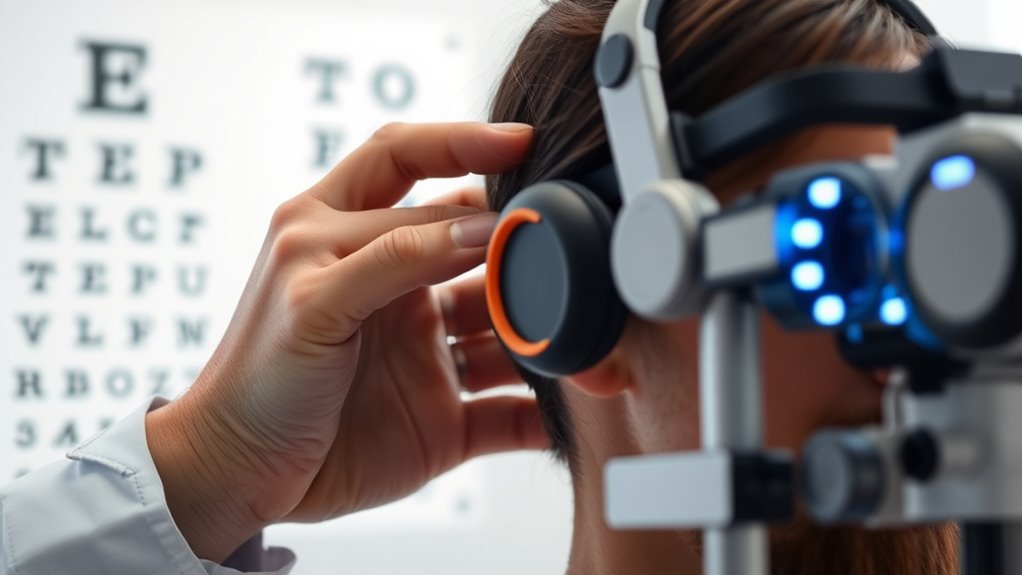When you check your vision and hearing, focus on clarity, contrast, and color perception, as well as peripheral and central fields of view. Track how quickly you respond to visual and auditory stimuli, and note any difficulties recognizing speech in noisy settings or locating sounds. Keep an eye on lifestyle factors like sleep and diet that affect your senses. Staying aware of these elements helps you maintain safety and overall clarity—continue exploring to learn more about keeping your senses sharp.
Key Takeaways
- Monitor visual acuity, contrast sensitivity, and color discrimination to detect early changes in sight.
- Track visual field performance to identify blind spots or peripheral vision loss.
- Assess hearing thresholds across frequencies to identify any hearing loss or impairments.
- Evaluate auditory processing speed and speech recognition, especially in noisy environments.
- Record response times for visual and auditory stimuli to monitor reflexes and processing efficiency.
Vision Clarity and Sharpness
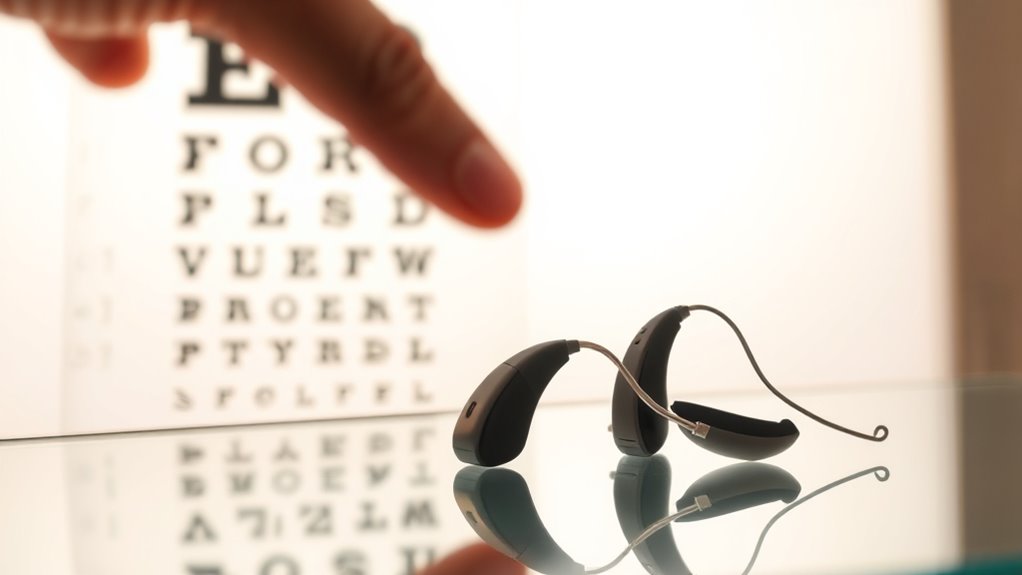
Maintaining clear and sharp vision is essential for everyday tasks and overall safety. Your visual acuity determines how well you see fine details, whether reading or recognizing faces. Regular eye checks help assess your visual sharpness and identify any decline early. Contrast sensitivity is equally important, as it affects your ability to distinguish objects from their background, especially in low-light or foggy conditions. If your contrast sensitivity decreases, you might struggle with everyday activities like driving at night or finding your way through dimly lit rooms. By monitoring these aspects, you verify your eyes function optimally. Routine vision tests allow eye care professionals to detect issues that could impair clarity and sharpness, helping you maintain the quality of your sight and avoid unnecessary risks. Additionally, understanding vision-related factors can guide you in choosing appropriate corrective measures or treatments when needed.
Color Perception and Discrimination

While sharpness and contrast sensitivity help you see clearly in various conditions, understanding how you perceive and differentiate colors is equally important. Your ability to perform color discrimination and accurately perceive hue plays a crucial role in daily tasks, from choosing clothing to reading traffic signals. Tests for hue perception assess how well you distinguish subtle differences between colors, which can reveal issues like color vision deficiencies. Difficulty in color discrimination might indicate early signs of color blindness or other visual problems. Regularly checking your color perception ensures you’re aware of any changes that could impact your safety or quality of life. Maintaining healthy color vision supports better decision-making and enhances your overall visual experience. Additionally, advancements in AI-driven visual assessments can provide more precise and accessible color vision testing options for users.
Peripheral and Central Vision Fields
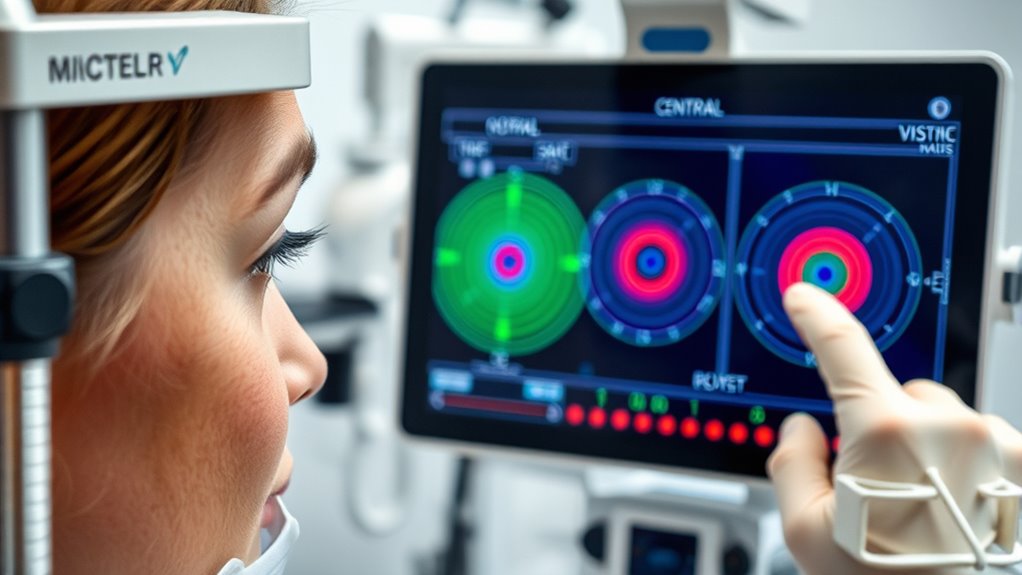
Your peripheral and central vision fields work together to give you a broad view of your surroundings. Visual field testing measures both your central and peripheral awareness, helping identify any blind spots or areas of reduced vision. Central vision allows you to focus on details directly in front of you, while peripheral vision detects objects and movement outside your direct line of sight. Maintaining healthy vision in both fields is essential for safe navigation and daily activities. During tests, you might be asked to look straight ahead and identify objects or light flashes in your peripheral vision. These assessments help detect issues early, such as glaucoma or neurological conditions, so prompt treatment can preserve your overall visual function and safety. Additionally, Visual field testing can be enhanced by AI-driven analysis, increasing accuracy and early detection of potential problems.
Visual Processing Speed and Response
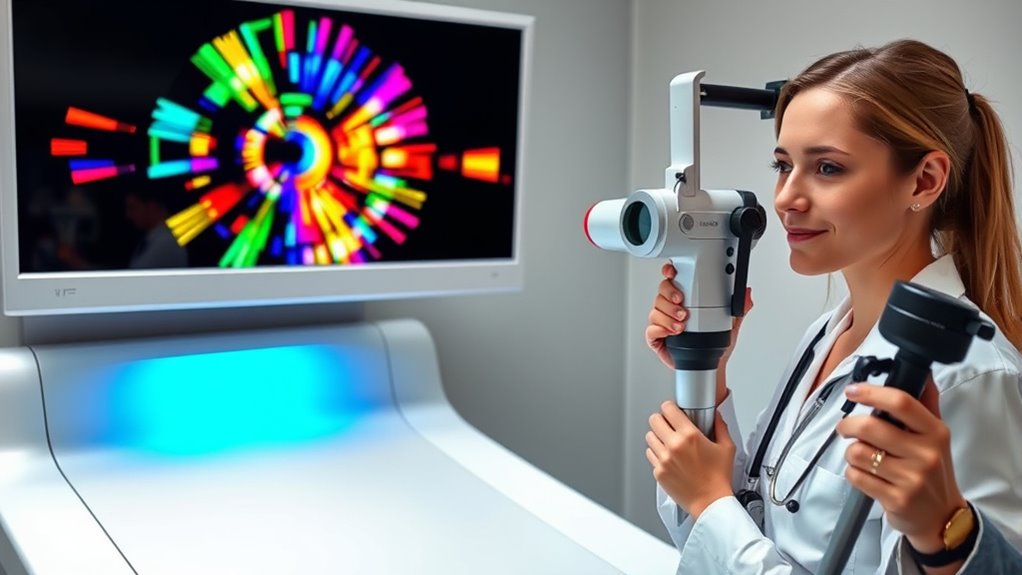
Your ability to quickly process visual information affects how fast you respond to your environment. Variations in processing speed can lead to different reaction times, impacting daily activities. Understanding these factors helps identify areas where your visual response might need improvement. Incorporating mindfulness practices can also enhance your overall mental well-being and improve reaction times.
Visual Reaction Time
Have you ever wondered how quickly your brain can process visual information and react? Your visual reaction time measures how fast you respond to stimuli, reflecting your reflex speed. This quick response is essential for everyday activities, from catching a falling object to driving safely. When you see a sudden obstacle, your brain processes the image and initiates a motor response in a fraction of a second. Faster reaction times indicate efficient visual processing, while delayed responses may signal underlying issues. Regularly checking your visual reaction time can help identify early signs of decline or impairment. Improving your reflex speed through exercises and mental focus can enhance your overall responsiveness. Additionally, understanding the importance of reaction time can help you take proactive steps to maintain your sensory and motor skills. Understanding and tracking this aspect of your vision health is crucial for maintaining safety and sharpness in daily life.
Processing Speed Variability
Processing speed variability refers to the fluctuations in how quickly your brain interprets and responds to visual information. These changes can affect your ability to process visual stimuli efficiently, impacting everyday tasks. Neural transmission plays a vital role, as delays or inconsistencies can slow response times. Sensory integration also influences this variability, as your brain combines visual signals with other sensory input to produce a coordinated response. To better understand your processing speed, consider these factors:
- Variability in reaction times during visual tasks
- Changes in response accuracy under different conditions
- Impact of distractions on visual processing speed
- Fluctuations in neural transmission efficiency
Enhanced understanding of neural transmission can help in developing strategies to improve response consistency.
Tracking these aspects helps identify issues that may require attention or intervention.
Hearing Sensitivity and Thresholds
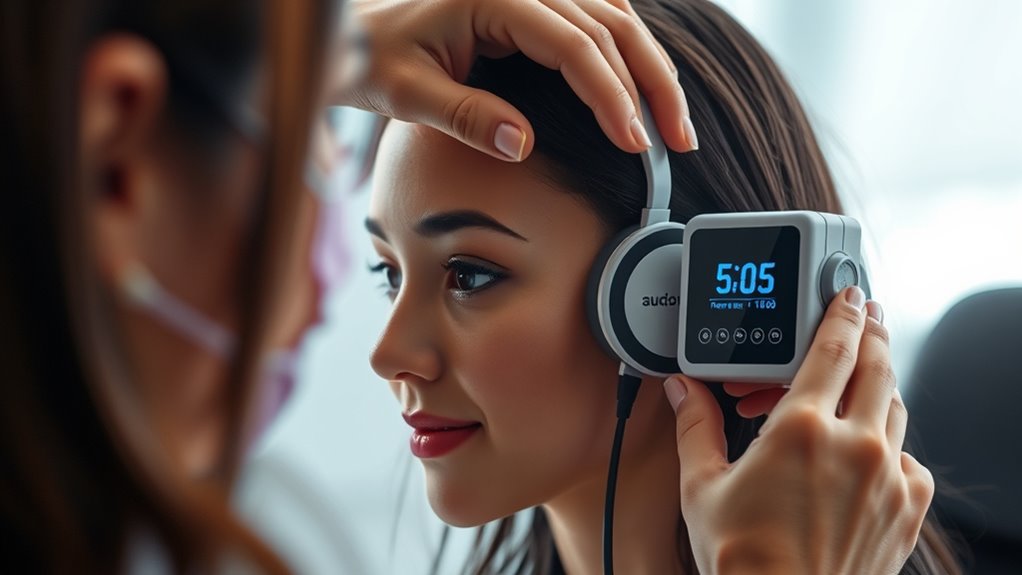
How sensitive your hearing truly is can be measured through specific tests that determine your hearing thresholds. These thresholds indicate the softest sounds you can detect at different frequencies, reflecting your overall hearing sensitivity. Understanding auditory thresholds helps identify early signs of hearing loss and guides appropriate interventions. The table below illustrates how thresholds vary across frequencies and what they reveal about hearing health:
| Frequency (Hz) | Threshold (dB HL) | Interpretation |
|---|---|---|
| 250 | 10 | Normal hearing at low frequencies |
| 1000 | 5 | Excellent hearing sensitivity |
| 4000 | 15 | Slight sensitivity loss |
| 8000 | 20 | Moderate hearing loss |
Monitoring these thresholds enables you to track changes in hearing sensitivity over time, ensuring timely action if needed. Regular hearing assessments can help detect early signs of hearing loss and preserve auditory health.
Sound Localization and Spatial Awareness

Sound localization and spatial awareness are essential skills that allow you to identify the origin of sounds in your environment. These abilities help you navigate safely and respond quickly to auditory cues. To assess your sound localization and spatial awareness, consider these key points:
Understanding where sounds come from enhances safety and environmental awareness.
- Recognizing whether sounds come from front, back, or sides
- Determining the distance of a sound source
- Noticing changes when you move your head or body
- Differentiating between multiple overlapping sounds
Practicing these skills improves your overall hearing health and sharpens your awareness of your surroundings. For optimal effectiveness, understanding how indoor air quality can be up to 5 times worse than outdoor air can also influence environmental factors that affect auditory health. If you struggle with pinpointing sounds or noticing where they originate, it might indicate a need for further evaluation. Maintaining strong sound localization and spatial awareness supports better safety, communication, and environmental interaction.
Speech Recognition and Comprehension

Have you ever struggled to understand speech in noisy environments or when multiple people talk at once? This challenge relates directly to your speech recognition and comprehension abilities. Good speech comprehension relies on your brain’s ability to interpret spoken language accurately, even amid background noise. When your hearing is fine, but understanding becomes difficult, it may signal issues with processing or clarity in language understanding. Regular hearing checks can help identify if your difficulty stems from auditory processing problems or other factors affecting speech recognition. Improving your ability to follow conversations enhances daily interactions and quality of life. Monitoring these aspects ensures your hearing health supports clear communication, helping you stay engaged and connected with those around you. Incorporating powerful persuasive words into your communication can further improve your conversational skills and comprehension.
Auditory Processing Changes Over Time

As you age, your brain’s ability to process auditory information can change, affecting how you interpret sounds and speech. Auditory neural decline leads to slower sound processing, causing delays in understanding conversation. You might notice difficulty focusing on speech in noisy environments or missing subtle cues. To understand these changes better, consider:
- Increased sound processing delays
- Reduced speed of auditory neural pathways
- Difficulty distinguishing similar sounds
- Challenges in following rapid speech
- Decluttering your environment can help reduce auditory distractions, making it easier to focus on conversations and interpret sounds accurately.
These shifts don’t mean you’re losing hearing, but they highlight changes in how your brain handles auditory signals. Recognizing these signs early can help you seek appropriate assessments and strategies to maintain effective communication as you age.
Impact of Lifestyle and Health Factors
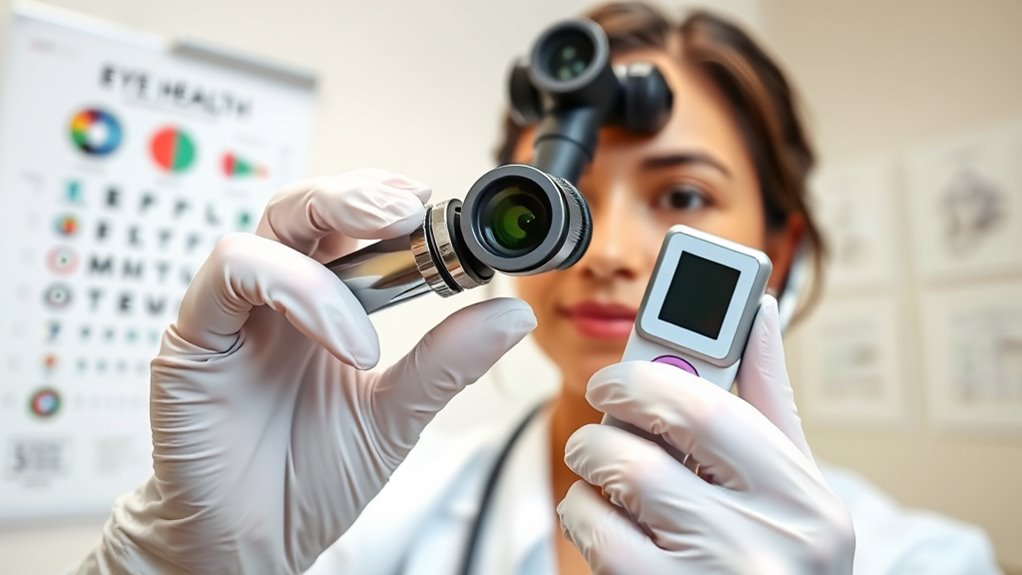
Your lifestyle choices can considerably influence your vision and hearing health. Eating a balanced diet, staying active, and getting enough sleep help protect your senses, while poor habits can accelerate decline. Understanding these connections empowers you to make better decisions for long-term sensory wellness.
Diet and Vision Health
Diet plays a crucial role in maintaining healthy vision, as what you eat directly impacts the health of your eyes. Poor dietary patterns can lead to nutrient deficiencies that harm your eyesight over time. To support ideal vision, focus on eating foods rich in essential nutrients like vitamins A, C, E, omega-3 fatty acids, and zinc. Here are four ways your diet influences eye health:
- Prevents age-related macular degeneration
- Reduces risk of cataracts
- Supports tear production and reduces dryness
- Shields eyes from oxidative stress
Exercise and Hearing Clarity
Regular exercise not only benefits your overall health but also plays a vital role in maintaining hearing clarity. Staying active improves blood flow, which supports the health of your auditory system. Additionally, regular physical activity can enhance visual acuity and eye coordination, helping you stay alert and responsive to your surroundings. Better eye coordination allows for more effective tracking of moving objects and improves balance, indirectly supporting hearing function. When you exercise consistently, you help reduce risks linked to cardiovascular issues and inflammation that can impair hearing. Maintaining a healthy lifestyle through regular activity keeps your sensory systems, including hearing, functioning at its best. Overall, exercise is a simple yet powerful way to support both your visual and auditory health.
Sleep’s Role in Sensory Function
Getting enough quality sleep is essential for maintaining ideal sensory function, as it directly influences how well your brain processes visual and auditory information. When you sleep well, your brain can effectively support dream enhancement and sensory integration, strengthening your senses. Poor sleep can impair your ability to interpret sensory signals, leading to decreased hearing clarity and visual sharpness. To optimize your sleep’s impact on sensory health, consider these factors:
- Consistent sleep schedule
- Reducing screen time before bed
- Managing stress levels
- Creating a comfortable sleep environment
Prioritizing restful sleep helps your brain perform sensory integration smoothly, boosting both your hearing and vision capabilities. Remember, good sleep isn’t just restorative—it’s crucial for sharp senses and overall sensory health.
Frequently Asked Questions
How Often Should Children Have Vision and Hearing Screenings?
You should follow screening guidelines that recommend children have vision and hearing screenings at least once a year, especially during routine checkups. These preventive measures help catch issues early and guarantee proper development. For younger children, screenings might be more frequent, such as every six months, if there are concerns. Regular screenings are essential to maintain your child’s overall health and prevent long-term problems.
What Are Early Signs of Declining Sensory Function?
You might notice early signs of declining sensory function, like difficulty seeing clearly, trouble hearing conversations, or increased sensitivity to light and sound. If you observe these, consider sensory therapy options or assistive devices to improve quality of life. Staying proactive helps manage changes early, so consult healthcare professionals promptly to evaluate your needs and explore suitable solutions to support your sensory health.
Can Lifestyle Changes Improve Vision and Hearing Health?
Coincidentally, your lifestyle habits and nutritional factors play a big role in improving your vision and hearing health. By eating nutrient-rich foods, staying active, and protecting your ears from loud noises, you can slow down decline. Regular exercise and a balanced diet boost blood flow and nutrient delivery to your eyes and ears. Avoid smoking and excessive alcohol, and consider routine checkups to maintain sharp vision and hearing for years to come.
Are There Specific Tests for Detecting Age-Related Sensory Decline?
Yes, there are specific tests for detecting age-related sensory decline. You should undergo screening techniques like visual acuity tests, contrast sensitivity assessments, and audiometry to check for sensory decline. These tests help identify early signs of vision and hearing issues, so you can take timely steps to manage or slow down deterioration. Regular screenings are essential, especially as you age, to maintain your overall sensory health.
How Do Medications Impact Vision and Hearing Capabilities?
Medications can considerably impact your vision and hearing through various medication side effects. Some drugs may cause blurred vision, dry eyes, or dizziness, affecting your sensory capabilities. Others might lead to hearing loss or ringing in your ears. It’s essential to discuss any changes with your healthcare provider, as they can adjust your medication to minimize sensory impact and guarantee your senses remain as sharp as possible.
Conclusion
Regular vision and hearing checks help you catch changes early, keeping your senses sharp. Did you know that nearly 20% of adults over 50 experience hearing loss, impacting daily communication? Tracking aspects like clarity, perception, and response guarantees you stay aware of your sensory health. By staying proactive, you can maintain better quality of life and detect issues before they become serious—so don’t skip those routine checkups!
